Operation Guide 3147
1
l
l
l
l
l
l
l
l
l
l
l
l
l
l
l
l
l
l
l
l
MO1010-EC
Getting Acquainted
Congratulations upon your selection of this CASIO watch. To get the most out
of your purchase, be sure to read this manual carefully.
Applications
The built-in sensors of this watch measure barometric pressure, temperature
and altitude. Measured values are then shown on the display. Such features
make this watch useful when hiking, mountain climbing, or when engaging in
other such outdoor activities.
Keep the watch exposed to bright light
The electricity generated by the solar cell of the
watch is stored by a built-in battery. Leaving or
using the watch where it is not exposed to light
causes the battery to run down. Make sure the
watch is exposed to light as much as possible.
• When you are not wearing the watch on your
wrist, position the face so it is pointed at a
source of bright light.
• You should try to keep the watch outside of
your sleeve as much as possible. Charging is
reduced significantly if the face is covered only
partially.
l
l
l
l
l
l
l
l
l
l
l
Bright light
Solar cell
• The watch continues to operate, even when it is not exposed to light.
Leaving the watch in the dark can cause the battery to run down, which will
cause some watch functions to be disabled. If the battery goes dead, you
will have to re-configure watch settings after recharging. To ensure normal
watch operation, be sure to keep it exposed to light as much as possible.
Bright light
Electrical
energy
All
functions
enabled
LEVEL 1
LEVEL 2
LEVEL 3
LEVEL 4
Charge
Solar cell
(Converts light to
electrical power.)
Rechargeable battery
LEVEL 1
LEVEL 2
LEVEL 3
LEVEL 4
Some
functions
disabled
Dis-
charge
Battery charges in the light. Battery discharges in the dark.
• The actual level at which some functions are disabled depends on the
watch model.
• Frequent display illumination can run down the battery quickly and require
charging. The following guidelines give an idea of the charging time
required to recover from a single illumination operation.
Approximately five minutes exposure to bright sunlight coming in through
a window
Approximately 50 minutes exposure to indoor fluorescent lighting
• Be sure to read “Power Supply” for important information you need to
know when exposing the watch to bright light.
If the display of the watch is blank...
If the display of the watch is blank, it means that the watch’s Power Saving
function has turned off the display to conserve power.
• See “Power Saving” for more information.
Warning!
• The measurement functions built into this watch are not intended for
taking measurements that require professional or industrial precision.
Values produced by this watch should be considered as reasonable
representations only.
• CASIO COMPUTER CO., LTD. assumes no responsibility for any loss,
or any claims by third parties that may arise through the use of this
watch.
About This Manual
• Button operations are indicated using the letters shown in the illustration.
• Each section of this manual provides you with the information you need to
perform operations in each mode. Further details and technical information
can be found in the “Reference” section.
(Light)(Light)
General Guide
• The illustration below shows which buttons you need to press to navigate
between modes.
• In any mode, press L to illuminate the display.
• You can press the C button to go directly from the Timekeeping Mode to
the Altimeter Mode. To go to the Altimeter Mode from the Barometer/
Thermometer, World Time, Stopwatch, Countdown Timer, Alarm, or Data
Recall Mode, first enter the Timekeeping Mode and then press the C
button.
Timekeeping Mode
Altimeter Mode
World Time Mode
Data Recall Mode
Countdown
Timer Mode
Press D.
Stopwatch Mode
Barometer/
Thermometer Mode
Alarm Mode
▲
▲
▲
▲
Press D.
▲
Press C.
▲
▲
▲
Radio-controlled Atomic Timekeeping
This watch receives a time calibration signal and updates its time setting
accordingly.
• This watch is designed to pick up the time calibration signals transmitted in
Germany (Mainflingen), England (Anthorn), the United States (Fort Collins),
China (Shangqiu), and Japan (Fukushima, Fukuoka/Saga).
Current Time Setting
This watch adjusts its time setting automatically in accordance with a time
calibration signal. You also can perform a manual procedure to set the time
and date, when necessary.
• The first thing you should do after purchasing this watch is to specify
your Home City (the city where you normally will use the watch). For
more information, see “To specify your Home City” below.
• When using the watch outside the areas covered by the time signal
transmitters, you will have to adjust the current time setting manually as
required. See
“Timekeeping” for more information about manual time
settings.
• The U.S. time calibration signal can be picked up by the watch while in
North America. The term “North America” in this manual refers to the area
that consists of Canada, the continental United States, and Mexico.
To specify your Home City
1. In the Timekeeping Mode, hold down A until
the city code starts to flash, which indicates
the setting screen.
2. Press E (east) and B (west) to select the
city code you want to use as your Home City.
LON : London
PAR, BER : Paris, Berlin, Milan, Rome,
Amsterdam, Hamburg, Frankfurt,
Vienna, Barcelona, Madrid
ATH : Athens
HKG : Hong Kong
TPE, TYO : Taipei, Tokyo
LAX :Los Angeles, San Francisco, Las Vegas, Seattle/Tacoma,
Vancouver, Tijuana
City code
Hour : Minutes
PM
indicator
Seconds
DEN :Denver, El Paso, Edmonton, Culiacan
CHI :Chicago, Houston, Dallas/Fort Worth, New Orleans, Winnipeg,
Mexico City
NYC :New York, Detroit, Miami, Boston, Montreal
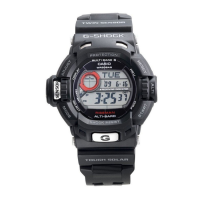
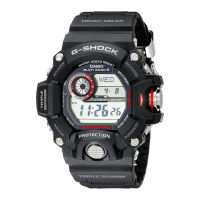
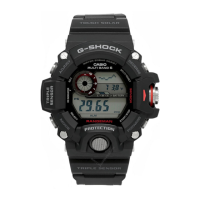


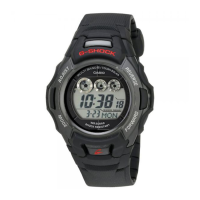

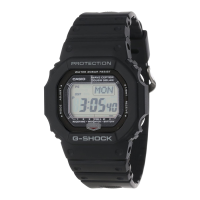


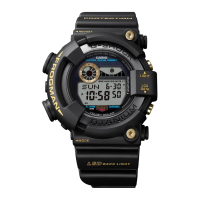

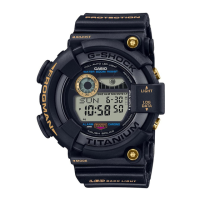
